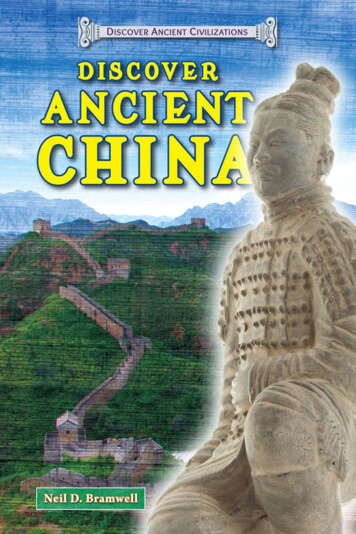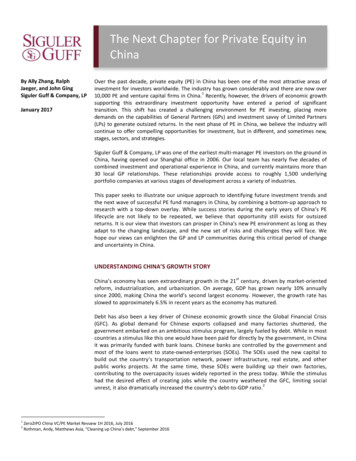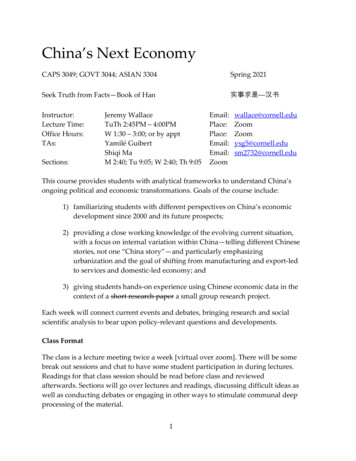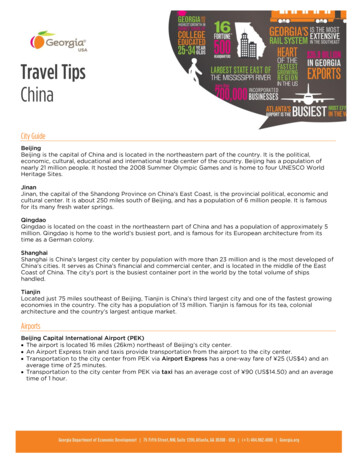
Transcription
DISCOVERANCIENTCHINA
Ancient China18th Century b.c. — a.d. 5th CenturyGobi DesertC H I N A Shang Dynasty c. 1523–1027 b.c. Qin Dynasty 221 b.c.–207 b.c. Han Dynasty 206 b.c– a.d. 220Current borders of China
BeijingSeaofJapanYellow RiverYellow SeaYangzi RiverShanghaiEastChina SeaPacific OceanSouthChina Sea
Copyright 2014 by Enslow Publishers, Inc.All rights reserved.No part of this book may be reproduced by any meanswithout the written permission of the publisher.This book originally published as Ancient China in 2004.Library of Congress Cataloging-in-Publication DataBramwell, Neil D., 1932Discover ancient China / Neil D. Bramwell.p. cm. — (Discover ancient civilizations)Includes bibliographical references and index.Summary: “Learn about the art and cultural contributions, family life, religions and people ofancient China”—Provided by publisher.ISBN 978-0-7660-4194-31. China—Civilization—To 221 B.C.—Juvenile literature. 2. China—Civilization—221 B.C.960 A.D.—Juvenile literature. I. Title.DS741.65.B73 2012931—dc232012011570Future editions:Paperback ISBN: 978-1-4644-0331-6EPUB ISBN: 978-1-4645-1185-1Single-User PDF ISBN: 978-1-4646-1185-8Multi-User PDF ISBN: 978-0-7660-5814-9Proudly sourced and uploaded by [StormRG]Kickass Torrents TPB ExtraTorrent h33tThis is the PDF version 1.0.To Our Readers: We have done our best to make sure all Internet Addresses in this book were activeand appropriate when we went to press. However, the author and the publisher have no control overand assume no liability for the material available on those Internet sites or on other Web sites they maylink to. Any comments or suggestions can be sent by e-mail to comments@enslow.com or to theaddress on the back coverPhoto Credits: 2012 Photos.com, a division of Getty Images. All rights reserved., pp. 26-27, 54, 61,63; 1998-2004, TravelChinaGuide.com, pp. 22, 24; AP Photos/Anat Givon, p. 77; AP Photos/Huang jundong sx—Imaginechina, p. 74; AP Photos/Xia yu gz—Imaginechina, p. 73; Clipart.com/ 2012 Photos.com, a division of Getty Images. All rights reserved., p. 32(bottom), 50, 76, 83; Corel Corporation, pp. 32(top), 42-43, 66-67; Enslow Publishers, Inc, p. 20; China NationalTourism Administration, p. 90; Courtesy of Government Printing Office, Republic of China, p. 78;hanhanpeggy/ 2012 Photos.com, a division of Getty Images., pp. 86-87; Hemera Photo Objects,p. 79; Holger Mette / 2012 Photos.com, a division of Getty Images. All rights reserved., pp. 12-13,HU-JUN/ 2012 Photos.com, a division of Getty Images. All rights reserved., pp. 34-35; Inna Felker/ 2012 Photos.com, a division of Getty Images. All rights reserved., p. 18; Kristin McCarthy/ Enslow Publishers, Inc, pp. 4-5; Shutterstock, pp. 75, 88, 92Cover Photo Credits: Great Wall: 2012 Photos.com, a division of Getty Images. All rightsreserved.;Terra-cotta warrior: Shutterstock
Table ofCONTENTSChapter 1Chapter 2Chapter 3An Army Protects theFirst Emperor . 9History . 15Land, People, and Religion . 29Chapter 4Family Life: Education, Food,Clothing, Shelter . 56Chapter 5Arts and CulturalContributions . 70Chapter 6Government. 81Timeline. 95Glossary . 96Chapter Notes . 98Further Reading . 101Internet Addresses . 102Index . 103
Chapter 1An ARMYPROTECTSthe FIRSTEMPEROR
Discover Ancient ChinaIn Xi’an, a city in the Shaanxi province ofnorthwestern China, thousands of soldiers,perhaps more than seven thousand, stand information in three underground pits. Theyare ready to defend their emperor, whosebody lies entombed nearby, from any enemy.They have remained in formation, ready forbattle, for over two thousand years. Thesoldiers are 8 inches to 6 feet 2.5 inches tall,and are made of terra-cotta, a form of bakedclay. Each soldier’s features are unique to him.Their weapons, longbows, spears, battle-axes,and halberds, which combine a spear and abattle-ax, are stored nearby. These soldiersare known as the terra-cotta warriors, andthe 14,000-square-foot museum where theyreside is one of China’s most-visited culturalsites.The soldiers are arrayed in formationsaccording to their function in battle, ready toward off attackers from any direction. Somesoldiers are in kneeling positions while others« 10 »
An Army Protects the First Emperorare standing. There are also seventy-fourfull-size chariots, drawn by four horseseach, in which other soldiers or officersride. There are, as well, nearly six hundredlife-size Mongolian ponies.Each soldier wears a uniform whosecolor corresponds to his rank. The colorsare purple, blue, green, yellow, red, andorange. The uniforms range from heavyknee-length tunics and cloth leg wrappingsto armor made from hundreds of pieces ofiron shaped like fish scales.1The emperor’s tomb that these soldiershave been guarding for over two thousandyears took over thirty years to build and islocated west of the burial chambers of thearmy. The tomb itself has not yet beenexcavated, but according to legend, it issupposed to be a replica of his empire,with rivers of quicksilver (mercury) andmany marvels, including death traps forany tomb robbers.2« 11 »
The terra-cotta warriors who havebeen guarding the tomb of EmperorShi Huangdi were discovered in1974 by Chinese farmers who weredrilling a well.« 12 »
« 13 »
Discover Ancient ChinaShi Huangdi (Qin Shi Huang), theemperor who had this army buried toprotect himself for all time, founded thefirst empire of China in 221 b.c. His conquests united the many states that hadfought each other for years in China. Hecalled himself “August Sovereign,” thename that all emperors of China usedafterward. He was the founder of the Qindynasty. Dynasties are periods of rule bymembers of the same family, and most ofChina’s long history is divided into dynasties, beginning in about 1994 b.c. with theXia dynasty and lasting until a.d. 1911,with the end of the Qing dynasty. Thepolitical system of the three earliest dynasties, the Xia, Shang, and Zhou, was a feudalsystem. The dynasties that followed, beginning with the Qin, were centralizedempires.« 14 »
Chapter 2HISTORY
Discover Ancient ChinaChina is the birthplace of the world’soldest continuous civilization, with awritten history that began 3,500 years ago.Humans have lived in what is now Chinalong before history was recorded Archaeological evidence shows that humans whomade tools were living in China at leasttwelve thousand years ago. They lived indwellings dug into the earth and roofedover. Pigs and dogs had been domesticatedand pottery making had been learned.The Xia, Shang, and ZhouDynastiesBy 2205 b.c., China consisted of a numberof small states that, according to tradition,were conquered and united by the Xiadynasty (1994 to 1523 b.c.). From thatdynasty until a.d. 1911, the history ofChina tells of the rise and fall of dynasties.The first historical dynasty, the Shangdynasty, dates from 1523 to 1027 b.c.« 16 »
HistoryThe Shang kings were powerful rulers,with great armies at their command. Theycould send from three thousand to fivethousand soldiers into battle at a time.The soldiers in these armies used bronzeweapons that included a complex bow andarrow and a halberd. The army was drivento the scene of battle by chariots and wouldthen dismount to begin fighting.The Shang dynasty was overthrown bythe Zhou dynasty, whose rule lasted from1027 to 221 b.c. Under the Zhou dynasty,the government extended its control intonorth and south China by conquest andplanned settlements. In the later period ofZhou rule, the central government’s control became less strong. This period,known as the Spring and Autumn period,saw the growth of independent states.These states paid only a small allegiance tothe central government.« 17 »
Discover Ancient ChinaAn array of reproduced weapons on theGreat Wall of China. Soldiers in the armiesof the Shang kings used bronze weapons.« 18 »
HistoryThe Warring States PeriodBy 475 b.c., the independent states beganfighting each other so often that the periodfrom 475 to 221 has come to be called theWarring States period. Its end also markedthe end of the Zhou dynasty.1 Warfare waswaged with the composite bow, whosearrows were made with bronze or claypoints. Other weapons used during thisperiod of warfare included bronze spears,battle-axes, and halberds.The End of War: The Qin DynastyIn 221 b.c., peace was restored to theempire when China became united underthe Qin dynasty and the First Emperor.During the Qin dynasty, The achievementsof the Qin are numerous. During the Qindynasty, the language and writing of Chinawas standardized, and the vast empire wasunited by a vast system of roads and canals.« 19 »
Discover Ancient ChinaYELLOWSEAerviRgzinaYQIN DYNASTYEASTCHINASEAThe powerful Qin dynasty lastedfor only fifteen years.« 20 »
HistoryDespite its lasting influence, the Qindynasty ruled for only fifteen years. Thisdynasty ended with the murder of the FirstEmperor’s son in 207 b.c. Rebellion andcivil war had broken out even before thatevent, however. From these warring groupsemerged a farmer who lost every battle buthis last one. Liu Pang, also known as HanGaozu, the first commoner to rule China,became the first emperor to rule over the2Han dynasty.The Han DynastyThe Han dynasty continued the rule ofChina under a powerful central government. The empire was divided into fourteen commanderies and ten kingdomsruled by the emperor’s sons or nobles heappointed. The powerful bureaucracy thathad been set up by the Qin dynasty wasexpanded to reinforce the control of thecentral government.« 21 »
Discover Ancient ChinaA gourd-shaped drinking vesselfrom the Zhou dynasty.« 22 »
HistoryIt was during this period that government inspectors were sent to all regions ofthe empire. They reported back to thecentral office in the capital on the conditions and the administration in each ofthe inspector’s districts. The inspectorscommunicated with the capital via a postalsystem, which was set up along the mainhighways that linked the empire.The money to run the governmentcame from taxes. A land tax and a head taxwere imposed on the people. State incomealso came from taxes paid on silk andrevenues that came from governmentowned industries such as salt and iron.The Han dynasty continued its rulefrom 206 b.c. until a.d. 220, except for afifteen-year period from a.d. 8 to a.d. 23.During those years, Wang Mang’s Xindynasty ruled China. But the Xin dynastywas did not last for long. After which theHan dynasty was successfully restored.« 23 »
Discover Ancient ChinaA jade water container createdduring the Han DynastyBecause of the interruption caused byWang Mang, the Han dynasty was dividedinto the Former Han, or Western Han(206 b.c. to a.d. 8), and the Later Han, orEastern Han (a.d. 23 to 220).The Han dynasty had vast armies at itscommand and was able to expand theempire a great deal. In 137 b.c., the Hanemperor sent an army of three hundred« 24 »
Historythousand men to Mongolia. Within tenyears, the Han controlled Inner Mongolia.The Han then took control of Koreabetween 109 and 106 b.c. By 82 b.c. theHan dynasty had extended China’s bordersto Burma.The armies of the Han dynasty weremade up of farmers and professionalsoldiers as well as mercenary troops whowere recruited from north of the empire’sborders. At the age of thirty, every man inthe empire had to enroll and serve one yearin the army. For those men who served onthe frontiers of the empire, service waspermanent.However, as powerful as the Hanarmies were, they were never able toconquer the nomad tribes north of China,beyond what became known as the GreatWall. That wall was begun by the FirstEmperor and was expanded under laterdynasties to keep out invading nomads« 25 »
According to Chinese legend, the Great Wall is really ahuge dragon turned to stone. The length of the wallwas broken at intervals by watchtowers. It originallystretched for 3,700 miles along China’s border.
Discover Ancient Chinafrom China’s north. But It failed to do so.Invasion and attack from north of the wallwas a frequent threat in ancient China untilnorthern tribes finally succeeded in conquering China.Dynasties rose and fell in the centuriesafter the Han dynasty and China’s conquestby the Mongols and the Qing dynasty. Butthe powerful central state created by theQin dynasty, which had been expandedand strengthened by the Han dynasty,remained in place until the end of theempire in a.d. 1911. The concept of a powerful and virtuous emperor ruling througha vast bureaucracy under strict law andstrongly influenced by philosophies of thetime was adapted and used by the succeeding dynasties.« 28 »
Chapter 3LAND, PEOPLEand RELIGION
Discover Ancient ChinaChina is the largest country in theworld in population and the fourthlargest in area. China’s east coast is bordered by three seas, the Yellow Sea, theEast China Sea, and the South China Sea,which are all part of the Pacific Ocean.China’s northern border reaches Mongoliaand Russia while to the south, Chinareaches North Vietnam. To the west,China’s major neighbor is India.Northern China was and is cold anddry, suitable only for the cultivation ofwheat or barley and millet and pasture forsome horses and cattle. Most important tothe people in northern China is the depositby wind and dust storms of a rich, fertilesoil known as loess. Loess deposits, whichcan be hundreds of feet deep, providedshelter for the ancient Chinese, since theywere able to dig homes in them. SouthernChina was warm and tropical in part andsuitable for the cultivation of rice, tea, and« 30 »
Land, People, and Religionmulberry trees whose leaves provided thefood for silkworms. Those silkwormsprovided the Chinese with the material tomake silk, which was also produced inother regions. Silk has been an importantmaterial throughout Chinese history.Major RiversThe two major rivers in China are theYellow River (Huang He) and the YangziRiver (Chang Jiang). The Yellow Riverruns for approximately 3,395 miles, fromthe Kunlun Mountains in western China tothe Bo Hai, an arm of the Yellow Sea, in theeast, but its course has changed—or beenchanged—over the centuries. The YellowRiver has overflowed its banks countlesstimes in China’s long history, causingflooding over thousands of miles. Thatflooding has led to a vast deposit of loessfrom which the early centers of China1grew.« 31 »
Discover Ancient ChinamothcocoonsilkwormAccording to a Chinese legend, silk wasdiscovered in about 2700 B.C. in EmperorHaungdi’s garden. Only the Chinese knewhow to make silk for 3,000 years.« 32 »
Land, People, and ReligionChina’s longest river is the Yangzi,flowing 3,200 miles from the Tibetanplateau to the East China Sea. The Yangziis the longest river in Asia and the thirdlongest river in the world. Unlike theYellow River, the Yangzi is navigable. Largeships can navigate the Yangzi for up to1,000 miles from the coast to the interiorof China, after which smaller ships can2travel an additional 600 miles. Throughout China’s history, the Yangzi has been ahighway of communication, commerce,and trade from China’s coast deep into itsinterior. China is roughly divided intonorth and south regions by a line drawnmidway between the Yellow River and theYangzi River.Farming and MiningAgriculture was the main occupation ofthe Chinese under the Shang kings andthrough the Han Empire. There were few« 33 »
The Yangzi River has always played a major role inChinese history. For thousands of years, people haveused the river for water, irrigation, sanitation,transportation, industry, boundary-marking and war.
Discover Ancient Chinacities except those established as capitalsby the kings and emperors or local centersfor the administration of the government.Most of the population lived in small townsand villages whose inhabitants were connected by family or clan ties.While the majority of the populationwas made up of farmers, there were significant numbers of skilled artisans such asbronze makers, potters, and even makers ofmusical instruments such as bells andocarinas, which are oval wind instruments.3Beginning in the Qin dynasty and greatlyexpanded under the Han dynasty, therewas a large bureaucracy of governmentofficials.Farmers paid rent to the government inthe form of crops or labor to live on theland they farmed. They were also forced todonate some of their time to work ondikes, roads, and public buildings. Forcedlabor was also used to build defensive walls« 36 »
Land, People, and Religionof rammed earth with the hardness ofcement around the cities and larger towns.There were small numbers of merchantswho lived in the capital cities or traveledthe countryside.By the Shang dynasty, 1523 b.c. to1027 b.c., bronze was in wide use, and theShang kings used chariots and weapons ofbronze. Iron, first cast in 513 b.c., was ingeneral use by 400 b.c., mainly in agriculture. With the invention of the bellows,steel was being produced in China by thesecond century b.c.Early WritingThe history of Shang rule is derived fromvast numbers of bones and tortoise shellsdiscovered in Anyang, one of the Shangkings’ capitals. The bones and shells areinscribed with questions asked by the kingsand answers given by specialists practicedin the art of interpreting the cracks and« 37 »
A view of the Yellow River in China'sSichuan Province where it winds throughthe Tangke Grassland.
Discover Ancient Chinamarkings in the bones and shells that wereproduced by heating them. This practicewas known as divination. Oracles, peoplewho were considered to have a specialwisdom and the ability to foretell thefuture, would read the cracks in the bonesand answer questions asked of them bygovernment officials. Those questionsmight be about almost anything, because itis believed that the Shang kings werehighly superstitious. But they probablyasked questions about the worship ofancestors, what military actions should betaken, and whether those actions would besuccessful.In addition to the bones and tortoiseshells, official accounts are also derivedfrom writings on bamboo and wood. Theexistence of these written records showsthat writing was already highly developedby the Shang period. Its origin in China isstill unknown.4« 40 »
Land, People, and ReligionReligionReligion in China by the time of the Shangdynasty was made up of many elements.Ancestor worship was one of the manyfeatures of early Chinese religion. Ancestorworship was limited to the wealthier classesuntil the Han dynasty. Farmers and theirfamilies devoted their worship mainly tolocal gods asking for good crops and familyhealth. The various gods were honoredwith ceremonies, and sacrifices werecarried out by heads of families. One of therituals was divination, which often wasperformed to determine whether ancestorsdesired specific sacrifices or rituals. Associety became more organized, stateofficials, including the king, performedcertain rites and ceremonies.There was no official class of priests inancient China.5 But worship was conducted with help from an individual known« 41 »
According to legend, the use of tea was discovered byEmperor Shennong of China about 2737 B.C. Theearliest known mention of tea appeared in Chineseliterature of about A.D. 350. These workers areplanting tea in present-day China.
Discover Ancient Chinaas a shaman. Shamans enlisted the help ofcertain animals who were thought to have aspecial connection with the ancestorswhose advice and assistance were beingsought.6 Kings and emperors also assumedthe role of shaman.In the Shang dynasty, religion differedfrom place to place, each area having itsown local god. Many gods were the samegods with different names. Ultimately thegovernment made one god, Shangdi, theLord on High, the official god. Kings andministers were worshiped after their deathsbecause it was believed that they couldapproach Shangdi, the supreme god, onbehalf of the common people.In 1027 b.c., the Zhou dynasty conquered the Shang dynasty. Under the Zhouhuman sacrifice was officially forbidden.7Until then, humans as well as animalsincluding cattle, dogs, and pigs were sacrificed to the gods. Most of the humans« 44 »
Land, People, and Religionsacrificed were prisoners of war. Butvillagers may have fought and capturedpeople from other villages for humansacrifice.8 Human sacrifice was also madeduring burial ceremonies of kings. Thethousands of terra-cotta soldiers buriednear the First Emperor’s tomb may havebeen a substitute for the burial of actualsoldiers. The First Emperor had themassive warrior army constructed in orderto accompany him into the afterlife andprotect him thereA significant part of ancient Chinesereligion was based on certain philosophiesthat were more concerned with humanrelationships than with a person’s relationship to a personal god. The philosophiesaddressed the question of how to organizesociety and a person’s relationship withothers for his or her own good and thegreater good of the state.« 45 »
Discover Ancient ChinaPhilosophies: Legalism,Confucianism, and TaoismAncient China was home to three schoolsof philosophy that have affected thoughtand behavior throughout its history. Theseschools of philosophy are known asLegalism, Confucianism, and Taoism.LegalismLegalism is the belief that society must bebuilt on law and serve the interest of thestate. Legalism continued to exert a stronginfluence up to modern times and wasparticularly powerful in its effect on thegovernments of the Qin and Han dynasties.As Legalism was practiced, judges weresupposed to correctly identify a crime andits punishment as specifically set forth inlaw. Strict law must define the crime and itspunishment and not be subject to interpre9tation by the judge or other individuals.« 46 »
Land, People, and ReligionUnderlying Legalism is the belief in apowerful centralized state run by officialswho are appointed by a ruler who must beobeyed without question. The law, whichcould not be questioned, had to be madeknown to the public and administeredaccording to specific rules and regulations.By the time of the Han dynasty, the lawwas to be applied equally to all, commoners as well as the those in the nobility.But by the late Han dynasty, there weredistinctions based on rank in how the lawwas applied.ConfucianismAccording to Chinese tradition, Confuciuswas a thinker, political figure, educator.Confucius (551–479 b.c.), whose teachings led to a school of philosophy, livedduring the second half of the Zhou dynasty(1027–221 b.c.). His teachings have had aprofound effect on China throughout itshistory. Confucianism became the official« 47 »
Discover Ancient Chinaphilosophy in the Han dynasty. It dominated Chinese thought to the end of theempire in 1911.Little is known about Confucius’s life.Modern scholars base most of what theydo know on a collection of his sayings andstories about his life collected by hisfollowers that were written down afterConfucius’s death. This collection, calledthe Analects, was added to over thecenturies by other writers of philosophy.Confucius taught that man’s relationships with others begins in the family, fromfather to son, elder brother to youngerbrother. Good relationships within thefamily, beginning with those betweenfather and son, extend to one’s relationshipto strangers and finally to the relationshipbetween the ruler and his subjects. He didnot teach about a personal god or evenpromote a doctrine of religion. He didinclude in his teachings the doctrine of the« 48 »
Land, People, and ReligionMandate of Heaven and the belief inDestiny. The Mandate of Heaven statesthat Heaven calls for the most virtuousman to be China’s ruler. If that man loseshis virtue, he will in turn lose the Mandateof Heaven, and his dynasty will be overthrown. Destiny, beyond human control,dictated one’s condition in life by determining a person’s wealth and health.10Belief in the Mandate of Heaven andDestiny was central to Confucius’s teachingbecause it meant that people should behavein a way that fit in with their position inlife. Confucius did not believe that humansshould lead passive lives, however. Instead,he urged people to devote themselves toliving a moral life that followed the Way ofHeaven as taught by the ancient sages.11According to Confucius, every manhad the potential and duty to reach thesame state of virtue, or level of goodness,that the ancient sages had achieved. While« 49 »
Discover Ancient ChinaConfucius (center) is depicted on a visit to the Courtof Ch’u. No book definitely written by Confuciusexists. His disciples recorded his conversations andsayings in a book called the Analects.« 50 »
Land, People, and Religionacknowledging that Destiny was in controlof the human condition, he believed thathumans had the free will to choose to livegood lives.In Confucian thought, virtue couldonly be achieved within a carefully orderedsociety, which could only come aboutwhen selfishness and greed were overcomeby all people within that society. The wayto virtue was by achieving benevolence,which happened when people consideredothers before themselves.12 In order toknow virtue, it was the duty of every manto study the ancient sages, considered thesource of all virtue. People were able togain knowledge about these sages bystudying books, especially those known asthe Wu Jing (Wu Ching), or Five Classics.One of those books, called the Book ofChanges, includes ancient Chinese beliefsabout the universe. Another book that isentitled the Book of Rituals describes the« 51 »
Discover Ancient Chinarules governing all behavior betweenpeople. It also describes rites and rituals,including religious ceremonies such asthose honoring ancestors.13Mencius (or Mengzi), who lived from371 to 289 b.c., expanded upon theteachings of Confucius. Mencius taughtthat humans are basically good, but thatgoodness must be strengthened bypracticing rites and rituals. That practiceallowed one’s goodness to overcome theconstant threat of selfishness, consideredpart of human nature.TaoismA philosopher who lived at the same timeas Confucius was the father of a verydifferent school of thought. His teachingswere followed by many during the Handynasty even though Confucianism wasthe official philosophy. This philosopher isknown as Lao Zi (Lao Tzu). Lao Tzi wasborn in the sixth century b.c. and he was« 52 »
Land, People, and Religionacquainted with Confucius. His philosophy, known as Taoism, is contained in theLao Zi (Lao Tzu), or Daodejing (Tao TeChing). The Lao Zi, which translates as“Classic of the Way and Virtue,” is writtenin parables and verse. It calls for humans tolive in natural harmony with the Tao, orDao, which is considered a cosmic unitythat underlies all things. Taoism, unlikeConfucianism, teaches that the bestgovernment is the one that governs theleast.14 The less people strive, and the lessthe government interferes, the happier allwill be. Taoism is based on one’s acceptance of his or her natural state. In Taoism,striving to move ahead in society is considered harmful.Taoism also opposed the practice ofthe rites and ceremonies that were practiced by the followers of Confucius’steachings. According to tradition, in ameeting between Confucius and Lao Zi,« 53 »
Lao Tzi is depicted in this sixth centuryDiscoverofAncientimage. He was the founderTaoism. ChinaHe wrote a book that explained his beliefscalled the Tao Te Ching.« 54 »
Land, People, and ReligionLao Zi implied that the rites were only thewords of dead men and therefore useless.15Like Confucianism, Taoism soughtorder in one’s personal life as well as in thestate. But unlike Confucianism, Taoismtaught that the ruler must avoid actionssuch as honoring individuals or creatingitems that could lead to desire. A passagefrom the Daodejing makes this quite plain.There is no crime greater thanhaving too many desires; There is nodisaster greater than not being content;There is no misfortune greater than16being covetous.China was, and is, a land of manydifferent cultures. One reason why Chinesecivilization has endured can be traced tothe beliefs of its people and the teachingsof its philosophers.« 55 »
Chapter 4Family Life:EDUCATION,FOOD, CLOTHING,SHELTER« 56 »
Family Life: Education, Food, Clothing, ShelterIn ancient China, most families lived onfarms. The ancient Chinese farm wasgenerally small, only about fifteen acres.All the members of a family worked on afarm. Under the Zhou Dynasty, certainsections of a farmer’s land were set asidefor the nobility. The noble’s land wasworked by serfs, who were bound underthe feudal system to work on a farm butdid not own the land. They were subject tothe will of the landowner. Farming washard work, as farmers’ tools at the timewere mostly made of bone, wood, andstone. With the unification of China underthe Qin dynasty, however, feudalism wasabolished, people could own land, andindividuals were taxed by the government.The Development of the CalendarIt was essential for a farmer to know whento begin planting his crops. One of themost important functions of the emperor« 57 »
Discovering Ancient Chinawas to inform farmers of the proper time tobegin planting. During the Shang dynasty,the development of a calendar was alreadyunder way. In it, a week consisted of tendays, and each day was measured by ten“Heavenly Stems” and twelve “EarthlyBranches” in a recurring cycle of sixty days.By 104 b.c., during the Han dynasty, thefour seasons as we now know them were firstfixed according to a calenda
Discover Ancient China « 16 » C. hina is the birthplace of the world’s oldest continuous civilization, with a written history that began 3,500 years ago. Humans have lived in what is now China long before history was recorded Archae-ological evidence shows that humans who made tools were living in









